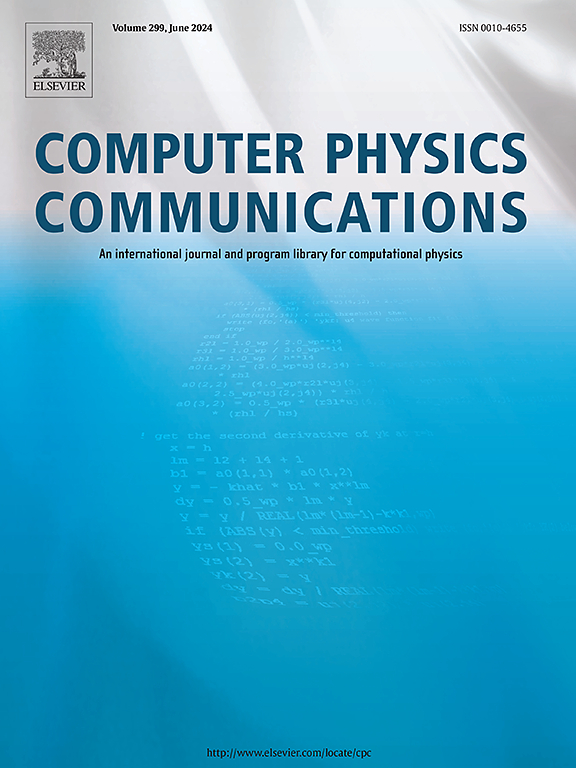数据驱动的空气中流线型排放简化模型
IF 3.4
2区 物理与天体物理
Q1 COMPUTER SCIENCE, INTERDISCIPLINARY APPLICATIONS
引用次数: 0
摘要
我们提出了一个计算框架来模拟细丝放电,其中通道被表示为导电圆柱段。该框架需要一个模型来预测下一个时间步长通道的位置、半径和线路电导率。利用这些信息,更新数值网格上的电导率,并通过求解变系数泊松方程计算新的电势。使用了支持自适应网格细化的并行场求解器,并且该框架提供了一个Python接口,以便于进行实验。我们演示了如何使用该框架来模拟空气中的正流光放电。首先,生成了1000个轴对称正流光模拟数据集,其中施加的电压和电极几何形状是不同的。从该数据集导出了拖缆半径、速度和线电导率的拟合表达式,并将拖缆前面的高场区域的大小作为输入。然后,我们构造了一个包含随机分支模型的空气中正流子的简化模型。简化模型与来自数据集的轴对称模拟比较好,同时允许空间和时间步长大几个数量级。简化模型的三维模拟与实验观察到的放电形态相似。该模型运行效率很高,在台式计算机上使用20+流线进行3D模拟需要4-8分钟。本文章由计算机程序翻译,如有差异,请以英文原文为准。
Data-driven reduced modeling of streamer discharges in air
We present a computational framework for simulating filamentary electric discharges, in which channels are represented as conducting cylindrical segments. The framework requires a model that predicts the position, radius, and line conductivity of channels at a next time step. Using this information, the electric conductivity on a numerical mesh is updated, and the new electric potential is computed by solving a variable-coefficient Poisson equation. A parallel field solver with support for adaptive mesh refinement is used, and the framework provides a Python interface for easy experimentation. We demonstrate how the framework can be used to simulate positive streamer discharges in air. First, a dataset of 1000 axisymmetric positive streamer simulations is generated, in which the applied voltage and the electrode geometry are varied. Fit expressions for the streamer radius, velocity, and line conductivity are derived from this dataset, taking as input the size of the high-field region ahead of the streamers. We then construct a reduced model for positive streamers in air, which includes a stochastic branching model. The reduced model compares well with the axisymmetric simulations from the dataset, while allowing spatial and temporal step sizes that are several orders of magnitude larger. 3D simulations with the reduced model resemble experimentally observed discharge morphologies. The model runs efficiently, with 3D simulations with 20+ streamers taking 4–8 minutes on a desktop computer.
求助全文
通过发布文献求助,成功后即可免费获取论文全文。
去求助
来源期刊

Computer Physics Communications
物理-计算机:跨学科应用
CiteScore
12.10
自引率
3.20%
发文量
287
审稿时长
5.3 months
期刊介绍:
The focus of CPC is on contemporary computational methods and techniques and their implementation, the effectiveness of which will normally be evidenced by the author(s) within the context of a substantive problem in physics. Within this setting CPC publishes two types of paper.
Computer Programs in Physics (CPiP)
These papers describe significant computer programs to be archived in the CPC Program Library which is held in the Mendeley Data repository. The submitted software must be covered by an approved open source licence. Papers and associated computer programs that address a problem of contemporary interest in physics that cannot be solved by current software are particularly encouraged.
Computational Physics Papers (CP)
These are research papers in, but are not limited to, the following themes across computational physics and related disciplines.
mathematical and numerical methods and algorithms;
computational models including those associated with the design, control and analysis of experiments; and
algebraic computation.
Each will normally include software implementation and performance details. The software implementation should, ideally, be available via GitHub, Zenodo or an institutional repository.In addition, research papers on the impact of advanced computer architecture and special purpose computers on computing in the physical sciences and software topics related to, and of importance in, the physical sciences may be considered.
 求助内容:
求助内容: 应助结果提醒方式:
应助结果提醒方式:


